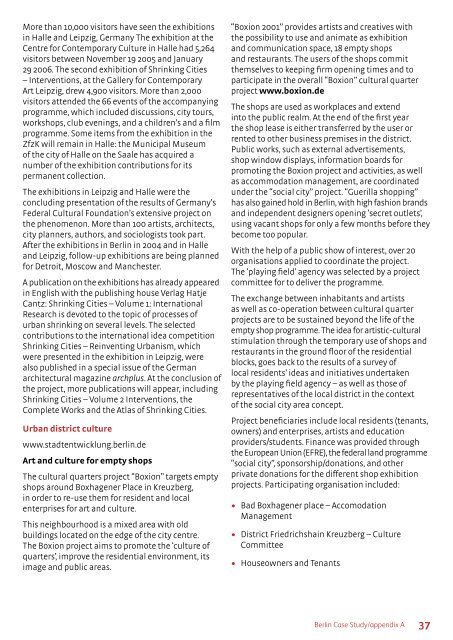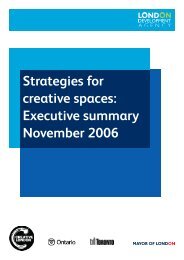Berlin Case Study - Cities Institute
Berlin Case Study - Cities Institute
Berlin Case Study - Cities Institute
You also want an ePaper? Increase the reach of your titles
YUMPU automatically turns print PDFs into web optimized ePapers that Google loves.
More than 10,000 visitors have seen the exhibitions<br />
in Halle and Leipzig, Germany The exhibition at the<br />
Centre for Contemporary Culture in Halle had 5,264<br />
visitors between November 19 2005 and January<br />
29 2006. The second exhibition of Shrinking <strong>Cities</strong><br />
– Interventions, at the Gallery for Contemporary<br />
Art Leipzig, drew 4,900 visitors. More than 2,000<br />
visitors attended the 66 events of the accompanying<br />
programme, which included discussions, city tours,<br />
workshops, club evenings, and a children’s and a film<br />
programme. Some items from the exhibition in the<br />
ZfzK will remain in Halle: the Municipal Museum<br />
of the city of Halle on the Saale has acquired a<br />
number of the exhibition contributions for its<br />
permanent collection.<br />
The exhibitions in Leipzig and Halle were the<br />
concluding presentation of the results of Germany’s<br />
Federal Cultural Foundation’s extensive project on<br />
the phenomenon. More than 100 artists, architects,<br />
city planners, authors, and sociologists took part.<br />
After the exhibitions in <strong>Berlin</strong> in 2004 and in Halle<br />
and Leipzig, follow-up exhibitions are being planned<br />
for Detroit, Moscow and Manchester.<br />
A publication on the exhibitions has already appeared<br />
in English with the publishing house Verlag Hatje<br />
Cantz: Shrinking <strong>Cities</strong> – Volume 1: International<br />
Research is devoted to the topic of processes of<br />
urban shrinking on several levels. The selected<br />
contributions to the international idea competition<br />
Shrinking <strong>Cities</strong> – Reinventing Urbanism, which<br />
were presented in the exhibition in Leipzig, were<br />
also published in a special issue of the German<br />
architectural magazine archplus. At the conclusion of<br />
the project, more publications will appear, including<br />
Shrinking <strong>Cities</strong> – Volume 2 Interventions, the<br />
Complete Works and the Atlas of Shrinking <strong>Cities</strong>.<br />
Urban district culture<br />
www.stadtentwicklung.berlin.de<br />
Art and culture for empty shops<br />
The cultural quarters project “Boxion” targets empty<br />
shops around Boxhagener Place in Kreuzberg,<br />
in order to re-use them for resident and local<br />
enterprises for art and culture.<br />
This neighbourhood is a mixed area with old<br />
buildings located on the edge of the city centre.<br />
The Boxion project aims to promote the ‘culture of<br />
quarters’, improve the residential environment, its<br />
image and public areas.<br />
“Boxion 2001” provides artists and creatives with<br />
the possibility to use and animate as exhibition<br />
and communication space, 18 empty shops<br />
and restaurants. The users of the shops commit<br />
themselves to keeping firm opening times and to<br />
participate in the overall “Boxion” cultural quarter<br />
project www.boxion.de<br />
The shops are used as workplaces and extend<br />
into the public realm. At the end of the first year<br />
the shop lease is either transferred by the user or<br />
rented to other business premises in the district.<br />
Public works, such as external advertisements,<br />
shop window displays, information boards for<br />
promoting the Boxion project and activities, as well<br />
as accommodation management, are coordinated<br />
under the “social city” project. “Guerilla shopping”<br />
has also gained hold in <strong>Berlin</strong>, with high fashion brands<br />
and independent designers opening ‘secret outlets’,<br />
using vacant shops for only a few months before they<br />
become too popular.<br />
With the help of a public show of interest, over 20<br />
organisations applied to coordinate the project.<br />
The ‘playing field’ agency was selected by a project<br />
committee for to deliver the programme.<br />
The exchange between inhabitants and artists<br />
as well as co-operation between cultural quarter<br />
projects are to be sustained beyond the life of the<br />
empty shop programme. The idea for artistic-cultural<br />
stimulation through the temporary use of shops and<br />
restaurants in the ground floor of the residential<br />
blocks, goes back to the results of a survey of<br />
local residents’ ideas and initiatives undertaken<br />
by the playing field agency – as well as those of<br />
representatives of the local district in the context<br />
of the social city area concept.<br />
Project beneficiaries include local residents (tenants,<br />
owners) and enterprises, artists and education<br />
providers/students. Finance was provided through<br />
the European Union (EFRE), the federal land programme<br />
“social city”, sponsorship/donations, and other<br />
private donations for the different shop exhibition<br />
projects. Participating organisation included:<br />
• Bad Boxhagener place – Accomodation<br />
Management<br />
• District Friedrichshain Kreuzberg – Culture<br />
Committee<br />
• Houseowners and Tenants<br />
<strong>Berlin</strong> <strong>Case</strong> <strong>Study</strong>/appendix A<br />
37




